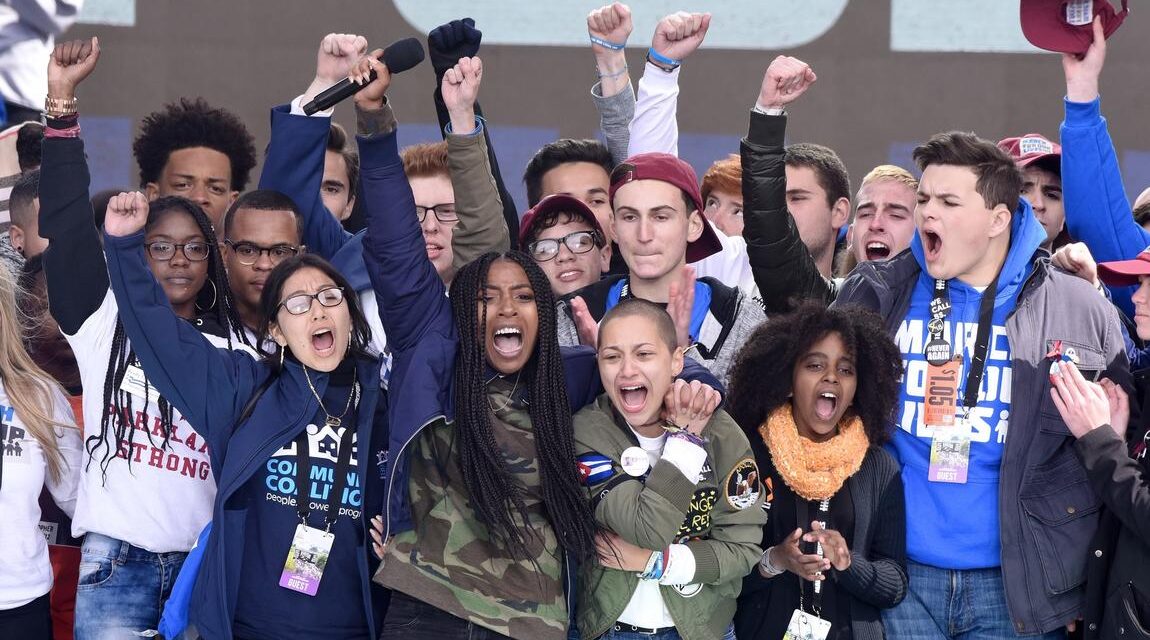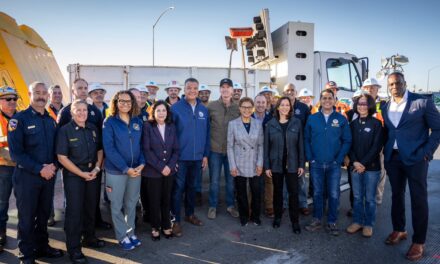
Marjory Stoneman Douglas students and march organizers gathered onstage to celebrate a triumphant march on Washington to combat gun violence. Photos by Danny R. Johnson/San Diego County News
By Danny R. Johnson – Washington, DC Correspondent
WASHINGTON, DC–March 24, 2018, was he day that belonged to the young. Some March for Our Lives speakers’ voices cracked, some were shrill, one fifth-grader on stage giggled nervously and others choked up. But so many were strong, powerful and unwavering. And then there was Samantha Fuentes, a Marjory Stoneman Douglas senior, who showed the true human face of gun violence on Saturday, in all its complicated, resilient glory.
Her face still scarred from a gunman’s bullets delivered on Valentine’s Day, she looked into the crush of humanity that stretched to the horizon along Pennsylvania Avenue. It had been only 38 days she had seen classmates slaughtered in her Holocaust history class. “Hello beautiful people of America,” Fuentes said. She started reciting a poem she had written about the Stoneman Douglas massacre titled “Enough,” describing how that day she cried “tears and blood at the same time.”
She halted. She faltered. She tried to compose herself.
And then she threw up.
Watching on a Jumbotron a half-mile from the stage, the crowd around me gasped.
And then Fuentes showed the meaning of Douglas Strong. “I just threw up on international television and it feels great!” Fuentes said.

More than 800,000 people showed up in Washington, DC to attend the March For Our Lives rally. Photos by Danny R. Johnson/San Diego County News
She finished her poem. And then she led the crowd in singing “Happy Birthday” to Nick Dworet, a classmate who would have turned 18 on Saturday had he not been among the 17 victims.
It was that kind of day. There were moments of sheer exhilaration, with rivers of attendees streaming in from all directions, packed liked sardines along a stretch of boulevard from the shadow of the U.S. Capitol to the outer fringe of the White House. There were moments of pure heartbreak, as a parade of young speakers from Chicago, Los Angeles, Washington, D.C., and Newtown, Conn., told of losing brothers, sisters and classmates to bullets in schools and on streets. In the end, it felt like something good was happening, something meaningful, even if it took so much pain and tragedy to birth it.
“Empowering,” said Ashaa Atkinson, 17, a junior from Coral Springs Charter High School, who watched with a group of classmates who made the bus trip from South Florida to show support and solidarity with neighboring Stoneman Douglas.
“I’m hopeful that there’ll be change this time,” said classmate Sierra Summers, 17. Unlike the suddenly famous faces from Parkland on the stage (“Em-ma, Em-ma!” the crowd chanted when Emma Gonzalez took the stage near the end) these teens felt lucky to be anonymous, fortunate that their school hadn’t been shredded by gunman’s bullets.
“I just hope this opens Congress’ eyes,” Atkinson said.
By design this was a day when the grownups were shoved to the sidelines, even the grieving parents of Parkland, to let the youth lead. “I say we were the only ones who could have made this moment possible,” Stoneman Douglas student Alex Wind said. He noted that Joan of Arc fought at 17 and Mozart composed his first symphony at 8.
Lead they did. Stoneman Douglas student Emma Gonzalez showed the power of silence, standing tearfully mute to mark the six minutes and 20 seconds of shooting in Parkland on Valentine’s Day. Martin Luther King Jr.’s 9-year-old granddaughter Yolanda showed the power of idealism, saying, “I have a dream that enough is enough, and that this should be a gun-free world, period.” Cameron Kasky showed the power of the sound bite, opening the rally by saying, “Welcome to the revolution.”

Young students from across the country marched together in the March For Our Lives event. Photos by Danny R. Johnson/San Diego County News
To their credit, the kids of Parkland broadened the scope on Saturday, inviting the everyday victims of gun violence from the inner-city streets of Chicago, D.C. and New York. But they also risked alienating some who might be sympathetic to their sensible gun control remedies, including the banning of semi-automatic weapons like AR-15s and high-capacity magazines. When singer Vic Mensa dedicated his performance to “all the young blacks with no weapons killed by police,” including Stephon Clark, a burglary suspect in Sacramento who ran from cops and was killed by multiple shots, I saw some older whites in my section leave.
The question going forward: Will this be a movement or a moment?
I watched Saturday’s rally near the National Archives, which seemed fitting for a day that might be recorded in history. In my first minute on Pennsylvania Avenue, two hours before the rally, I asked attendees where they were from: Philadelphia, Akron, Oregon, Massachusetts, Chicago, South Carolina, North Carolina, Atlanta, Michigan, Utah, Virginia, Orlando. I ran into two groups of Stoneman Douglas alumni and two packs of students from Broward.
They came by plane, bus and car. They came carrying signs that read, “Arms are for hugging” and “You can’t fix stupid but you can vote it out.” They came wearing stickers that read, “227 days until midterm elections” and buttons that read “We call BS” and “Oprah 2020.” They came with “Don’t shoot” painted on each palm and the names of Douglas victims written on their sneakers. They all wanted to be part of something big.
Kenzie Nicotrie, 9, of Lansing, Mich., sat on her uncle’s shoulders, carrying a sign that read, “Mark my words. We will be in our future history books.” Her mother, Sarah Nicotrie, said she booked plane tickets immediately after the march was announced.
“I think we’re at a tipping point,” Sarah Nicotrie said. “I wanted to support the Parkland kids. I mean, who doesn’t?”




